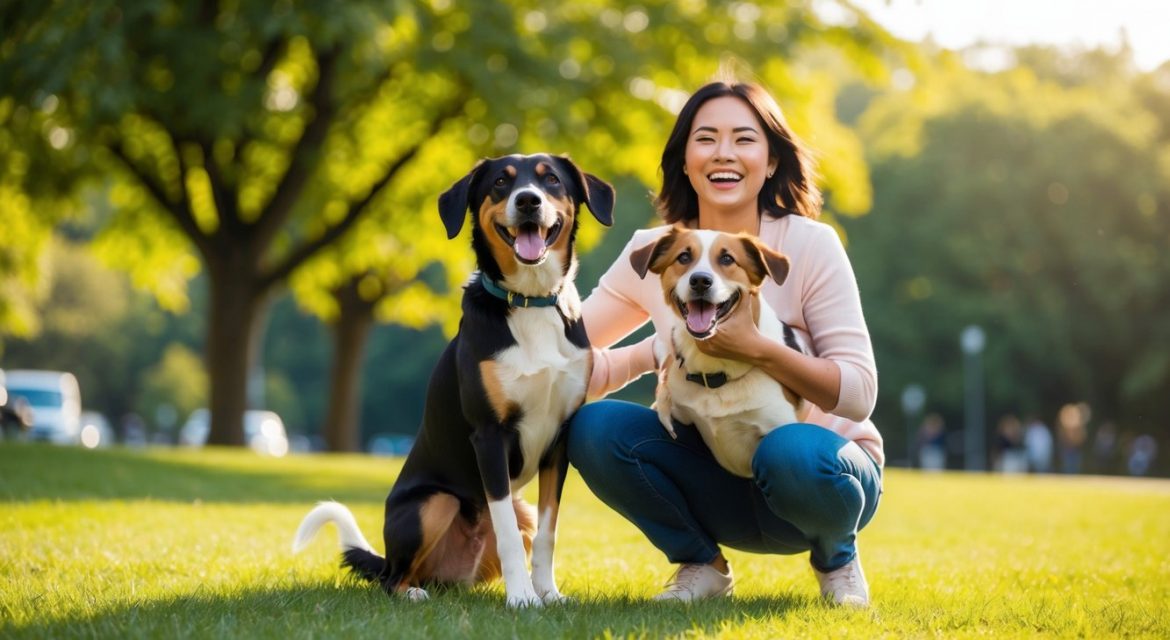Living with a dog brings countless moments of joy, learning, and companionship that truly enrich our daily lives. Dogs have a remarkable ability to fit into our routines while also helping us create healthier lifestyle habits.
When you share your home with a canine companion, you experience life differently. Morning walks get you moving, while evening cuddles reduce stress. As the experts at FOTP point out, your dog has a massive influence on your lifestyle, creating opportunities for more physical activity, social connections, and emotional support.
Understanding your dog’s unique personality and needs is essential for creating a harmonious household where both you and your four-legged friend can thrive.
Dog breeds have distinct traits that affect their care needs and compatibility with your lifestyle. Knowing these differences helps you make the right choice when adding a furry friend to your family.
Characteristics of Popular Breeds
Labradors and Golden Retrievers are known for their friendly, outgoing nature and make excellent family pets. They require regular exercise and enjoy swimming activities.
German Shepherds are intelligent, loyal and protective. These dogs excel at training and often work in security or service roles. They need both physical exercise and mental stimulation daily.
Smaller breeds like the Pug and French Bulldog have distinctive flat faces and enjoy shorter walks. They’re prone to breathing difficulties, especially in hot weather.
The elegant Greyhound is surprisingly a couch potato despite its racing background. They need short bursts of exercise but enjoy lounging afterwards.
King Charles Spaniels are gentle, affectionate companions who thrive on human interaction. They’re smaller but require regular grooming for their silky coats.
Choosing the Right Breed for Your Lifestyle
Each dog brings their own personality, quirks, and requirements to your home. That’s why it’s crucial to find a pet whose energy and temperament match your age, health, and lifestyle.
Whether you’re an active outdoor enthusiast or prefer quiet evenings at home, there’s a perfect canine match for every human—one that will help you live your best life together.
Understanding Canine Emotions
Dogs experience a range of emotions, including love and joy. Research has shown that dogs’ brains release oxytocin during positive interactions with their owners. This is the same hormone associated with bonding in humans.
Your dog communicates their affection in various ways. Tail wagging, excited greetings, and following you around the house are clear signs of attachment. Some breeds, like the affectionate King Charles Spaniel, may be more demonstrative than others.
It’s important to recognise that affection can be reinforcing for dogs, but not all dogs express or receive love in the same way. Some may prefer gentle strokes, while others enjoy playful interaction.
Dogs also display many unique behaviours to show affection. Learning to read these signals strengthens your bond.
Key Aspects of Veterinary Care
Professional veterinary care forms the cornerstone of your dog’s health and wellbeing. Regular visits to the vet ensure early detection of potential issues. They also provide essential preventive treatments that keep your furry friend happy and thriving.
Routine Health Check-Ups
Your dog needs regular veterinary examinations, typically once or twice yearly depending on age and health status. These check-ups allow your vet to monitor your dog’s overall condition and spot potential issues before they become serious problems.
During these visits, your vet will assess vital signs, weight, and body condition. They’ll also examine your dog’s eyes, ears, teeth, skin, and coat quality. For breeds like the Labrador Retriever, they may pay special attention to hip and joint health, while Bulldogs often require closer monitoring of respiratory function.
Dental assessments are particularly important as dental care is a crucial part of routine health. Poor dental health can lead to pain, infection, and even organ damage if bacteria enter the bloodstream.
Remember to bring any health concerns or behaviour changes to your vet’s attention during these visits.
Vaccinations and Parasite Control
Your dog requires specific vaccinations to protect against potentially fatal diseases. Core vaccines typically include those for parvovirus, distemper, hepatitis, and rabies, with additional vaccinations like Leptospirosis recommended based on lifestyle and regional risks.
Puppies need a series of initial vaccinations, followed by regular boosters throughout life. Your vet will establish a vaccination schedule specific to your dog’s needs.
Parasite control is equally essential. Regular treatments protect against:
- External parasites: Fleas, ticks, and mites
- Internal parasites: Roundworms, hookworms, whipworms, and tapeworms
Heartworm prevention is vital for many dogs, particularly Labradors and other active breeds who spend time outdoors. Bulldogs may need special attention to skin fold parasites due to their distinctive wrinkles.
Your vet will recommend year-round parasite control with specific treatments tailored to your dog’s risk factors and local environment.
Training and Behavioural Guidance
Effective training creates a harmonious relationship between you and your dog. Proper guidance helps address unwanted behaviours and ensures your pet understands what you expect from them.
Basic Obedience Training
Start training your dog with five essential commands: sit, stay, come, heel, and down. These basics form the foundation for more advanced training and help keep your dog safe in various situations.
For breeds like the German Shepherd and Golden Retrievers, begin training as early as 8 weeks old, as these intelligent breeds thrive on mental stimulation. Training provides numerous benefits for both you and your dog, creating a stronger bond.
Even small breeds like the Pug and French Bulldog need consistent training, though you may need to adjust sessions to be shorter due to their physical limitations. Use positive reinforcement techniques:
- Treats and praise for desired behaviours
- Consistent commands and hand signals
- Short, regular sessions (5-15 minutes)
- Patience and persistence
Addressing Behavioural Issues
When your dog develops unwanted behaviours like barking, chewing, or aggression, address them promptly with appropriate strategies. Understanding the root cause is crucial – is your German Shepherd barking due to boredom or territorial instincts?
For anxious breeds like the French Bulldog, create calming environments and use desensitisation techniques. Behavioural experts can investigate all relevant aspects of your dog’s life to determine the best approach.
Common solutions include:
- Increased exercise for high-energy dogs like Golden Retrievers
- Environmental management (removing triggers)
- Redirection to appropriate behaviours
- Consistent responses from all family members
For persistent issues, consider working with a qualified dog trainer who uses client-focused approaches to improve outcomes and strengthen your relationship.
Socialisation and Interaction
Dogs thrive on social connections with humans and other animals. Proper socialisation helps them develop confidence and reduces behavioural problems that stem from fear or anxiety.
Integrating Dogs into a Family
When bringing a new dog into your home, create a calm environment for them to adjust gradually. Socialisation is crucial for dogs of any age, not just puppies.
Introduce your dog to family members one at a time rather than overwhelming them with group interactions. This builds trust and reduces anxiety.
Key integration tips:
- Use positive reinforcement when your dog shows calm behaviour around family members
- Establish clear boundaries and consistent rules
- Give your dog their own space where they can retreat when needed
- Involve all family members in training and care routines
Children should be taught how to respect your dog’s space and signals. Dogs that lack early contact with children may display uncertain or even aggressive behaviour, so supervised interactions are essential.
Dogs and Their Relationship with Cats
Many dogs and cats can live together harmoniously with proper introduction. The success often depends on each pet’s personality and previous experiences.
When introducing your dog to a resident cat:
- Keep them separated initially, allowing them to smell each other through a closed door
- Use baby gates for visual contact while maintaining safety
- Reward calm behaviour from both animals
- Never force interactions
Socialisation helps dogs interact harmoniously with cats by developing better communication skills. Your dog needs to learn to read feline body language, which differs significantly from canine signals.
Monitor early interactions carefully and provide your cat with high places to escape if needed. With patience and consistent training, many dogs develop loving relationships with their feline housemates, sometimes even becoming cuddle partners!
Canine Health and Wellness
Proper care is essential for your dog’s physical and mental wellbeing. Regular check-ups and appropriate mental stimulation can significantly extend your pet’s lifespan and improve their quality of life.
Preventing Common Health Issues
Regular wellness visits to your veterinarian are crucial for catching potential problems early. Schedule annual check-ups to maintain your dog’s health regardless of breed.
Vaccinations protect your dog from serious diseases and should be kept up to date. Larger breeds like German Shepherds need special attention to joint health, while smaller breeds such as Chihuahuas often require dental care.
Essential preventative measures include:
- Regular exercise appropriate for your dog’s breed and age
- Maintaining a healthy weight through proper nutrition
- Parasite prevention (fleas, ticks, worms)
- Dental care, including regular teeth cleaning
Watch for breed-specific issues. German Shepherds may develop hip dysplasia, while Chihuahuas often face dental problems and patellar luxation.
Promoting Mental Well-Being
Mental health is as important as physical health for dogs. Lifestyle and exercise routines tailored to your dog’s specific needs help prevent behaviour problems and anxiety.
Daily physical activity—walks, play sessions, or agility training—provides necessary mental stimulation. German Shepherds thrive with job-like activities, whilst Chihuahuas enjoy puzzle toys and short training sessions.
Mental enrichment ideas:
- Rotate toys to maintain interest
- Use food puzzles to stimulate problem-solving
- Practise new commands or tricks regularly
- Provide safe socialisation opportunities
Environmental enrichment matters too. Create safe spaces where your dog can retreat when stressed. Even small changes in routine can cause anxiety, so maintain consistency when possible.
Adapting to the Aging Process
As your dog enters their senior years, physical and behavioural changes will occur that require adjustments to care and lifestyle.
These changes often include reduced mobility, greying fur, and increased health concerns that need special attention.
Caring for Senior Dogs
Senior dogs need more frequent veterinary visits to catch age-related issues early.
Regular health checks become essential as your dog ages. Watch for signs of discomfort, reduced activity, or appetite changes.
Proper nutrition is vital for maintaining your elderly dog’s health. Many breeds like Labrador Retrievers may need lower-calorie diets to prevent weight gain, while German Shepherds might require supplements for joint support.
Older dogs are more susceptible to various medical conditions, including arthritis, dental problems, and vision issues. Keep vaccinations current as recommended by your vet.
Monitor your dog’s weight closely, as obesity can worsen joint problems and reduce quality of life in breeds like Greyhounds, which may already face mobility challenges.
Modifications in Lifestyle and Care
Your home environment may need adjustments to accommodate your ageing companion.
Consider installing ramps or steps to help them access furniture or cars if mobility is limited.
Exercise requirements change with age. While still essential, walks should be shorter and gentler. Swimming offers excellent low-impact exercise for many older dogs.
Daily routine modifications:
- More frequent toilet breaks (reduced bladder control)
- Warmer sleeping areas (older dogs feel the cold more)
- Easy access to food and water bowls
Comfort becomes increasingly important. Provide orthopaedic beds to support ageing joints, especially for larger breeds like German Shepherds.
Cognitive decline may affect your dog’s behaviour. Maintaining mental stimulation through gentle puzzle toys and short training sessions helps keep their mind active and strengthens your bond of love.
Legal and Ethical Responsibilities
Owning a dog comes with important legal duties and moral obligations. You need to understand both the laws governing pet ownership and the ethical aspects of providing proper care to ensure your dog’s wellbeing.
Understanding Pet Ownership Laws
As a dog owner in the UK, you must comply with several legal requirements. Your dog is required by law to wear a collar and identity tag whenever in public spaces. This tag should include your name and address.
The Animal Welfare Act establishes that you must provide your dog with:
- A suitable environment
- Proper nutrition
- The ability to display normal behaviour patterns
- Appropriate housing
These aren’t merely suggestions—they’re legal obligations.
You’re also responsible for controlling your dog in public and cleaning up after them. Failure to do so can result in fines or other penalties.
Dog licencing requirements vary by location, so check with your local council about specific regulations.
Ethical Treatment of Dogs
Beyond legal requirements, you have ethical responsibilities toward your canine companion. Dogs aren’t simply possessions—they’re sentient beings deserving of respect and proper care.
This means prioritising your dog’s wellbeing by providing not just physical necessities but also mental stimulation and emotional support. Dogs need regular exercise, social interaction, and activities that engage their minds.
Building a relationship based on trust and care forms the foundation of ethical pet ownership. This trust shouldn’t be broken capriciously.
Modern views increasingly recognise dogs as family members, though this perspective hasn’t fully integrated into all animal protection laws. As a responsible owner, you should advocate for your dog’s needs and rights.
Frequently Asked Questions
Dog owners face many questions about providing the best care for their furry friends. These common queries cover health, behaviour, activities, and the impact of pet ownership on daily life.
What factors should be considered to provide a healthy lifestyle for a dog?
A balanced diet appropriate for your dog’s age, breed, and health status is crucial. High-quality dog food with proper portions helps maintain optimal weight and prevents obesity-related issues.
Regular veterinary check-ups are essential for preventive care. Vaccinations, parasite control, and dental examinations should be part of your dog’s healthcare routine.
Exercise needs vary by breed, age, and size. Large, active breeds may require several hours of daily activity, while smaller or older dogs might need gentle, shorter exercise sessions.
Mental stimulation through toys, training sessions, and social interactions prevents boredom and related behavioural problems. Even 15 minutes of training daily can make a significant difference.
How do certain behaviours indicate a dog’s well-being and happiness?
A content dog typically displays relaxed body language with a loose wagging tail and soft eyes. They may offer a “play bow” position when excited and happy to engage with you.
Healthy appetite, regular sleep patterns, and appropriate energy levels indicate overall wellbeing. Changes in these baseline behaviours often signal health concerns requiring attention.
Sociable behaviour with family members and other dogs suggests good adjustment and happiness. Excessive barking, hiding, or aggression might indicate stress or discomfort that needs addressing.
What are common behaviour problems in dogs and how can they be addressed?
Puppy biting is natural but needs gentle redirection to appropriate toys. Consistent training and positive reinforcement help puppies learn acceptable behaviour.
Toilet training accidents require patience and consistent routines. Take your puppy out frequently, especially after meals, naps, and play sessions, and reward successful outdoor elimination.
Separation anxiety manifests as destructive behaviour, excessive barking, or house soiling when left alone. Gradual desensitisation to your departures and arrivals can help reduce this anxiety.
Excessive barking often stems from boredom, territorial behaviour, or attention-seeking. Identifying the trigger and providing appropriate alternatives or training can reduce problematic barking.
Which daily activities are essential for maintaining a dog’s mental and physical health?
Regular exercise adapted to your dog’s age, breed, and health status is vital. This might include walks, play sessions, swimming, or agility training depending on your dog’s needs.
Training sessions provide mental stimulation while strengthening your bond. Even five-minute sessions of practising commands or learning new tricks can be beneficial.
Social interactions with other dogs and people help develop and maintain good behaviour. Dog parks, organised playdates, or friendly neighbourhood walks provide these opportunities.
Quiet time and adequate rest are equally important. Create a comfortable sleeping area where your dog can retreat when tired or overwhelmed.
What is the typical lifespan of domestic dogs based on their breed and care?
Small breeds typically live longer, often 12-16 years, while larger breeds generally have shorter lifespans of 8-12 years. Genetics plays a significant role in determining longevity.
Quality nutrition, regular exercise, dental care, and preventive healthcare can extend your dog’s lifespan by preventing or managing common health issues.
Regular weight management is crucial, as obesity can reduce lifespan by up to two years and increases the risk of diabetes, joint problems, and heart disease.
How can owning a dog influence the owner’s lifestyle and daily routine?
Dog ownership requires a time commitment. You need to allocate time for feeding, exercise, training, grooming, and veterinary care.
Dogs provide structure through their need for consistent routines. This can help you establish healthier patterns in your own life, including regular exercise and outdoor time.
Travel plans must consider your dog’s needs. You need to find pet-friendly accommodations or arrange proper care while you’re away. This requires additional planning and possible expenses.
Many dog owners report improved physical and mental health from the daily exercise and companionship their pets provide. The social connections formed through dog ownership can reduce isolation and stress.














